Educational apps have become immensely popular, consistently ranking among the most downloaded categories. Their appeal lies in their ability to offer interactive and personalised learning experiences.
Despite this, many educational institutions continue to rely on tried-and-tested methods, like traditional evaluation methods and labour-intensive paper-based processes. One reason for this is that people think it's hard to build educational software.
But that’s changing.
In this blog, we'll explore the challenges educational software addresses, the various types of educational software available and how Builder.ai makes it easier than ever to build it. 👇
What is educational software?
Educational software is a digital system designed to enhance learning experiences. It supports interactive, personalised education through various tools like virtual classrooms, tutorials, interactive games and assessments. This software makes learning more flexible, accessible and helps you meet the needs of different learning styles.
Challenges solved by educational software
1 - Education is expensive
Traditional education, especially higher education, can be prohibitively expensive. In fact, since 1980, the cost of tuition fees has increased by 1,200%.
This high cost of classroom education makes it hard for many students who want to learn to get into school.
Educational software significantly reduces these costs by removing the need for physical classrooms and offering online courses that reach a larger audience at a lower cost.
2 - All theory, no practice
It’s a common criticism that educational institutions put more emphasis on theory than practical application, which makes it difficult for students to apply concepts in real-world scenarios.
Educational software bridges this gap by incorporating interactive simulations and real-world problem-solving scenarios that allow students to apply theoretical concepts in virtual environments.
3 - One-size-fits-all classroom experience
Not all students are engaged by the same teaching techniques.
While traditional classrooms may rely on a one-size-fits-all approach, E-learning software uses gamification techniques to keep students engaged. According to a study, students using gamification are more engagedand show significant improvement in the quality of their solutions.
They also use adaptive learning technologies that adjust the learning path based on an individual’s performance and learning pace.
4 - Outdated assessment and evaluation process
The evaluation methods used for students have remained unchanged for decades. Research suggests thattraditional grading systems often fail to accurately measure how well students have learned. This is because they can be influenced by factors like test anxiety, social background or teacher bias.
Plus, traditional grading systems only measure memorisation and test performance rather than comprehensive understanding or critical thinking.
Educational software provides effective assessment tools, such as real-time feedback, continuous assessments and interactive quizzes that adapt based on the student's performance. They provide precise feedback to students and help educators find areas where students may need additional support.
5 - Cheating
Cheating continues to be one of the most difficult challenges for educational institutions. There are numerous cases where teachers and moderators leaked exams for monetary benefits. The most recent happened in India, which left the future of millions of students in doubt.
This severely undermines the integrity of educational institutions.
While traditional methods can’t address this, educational software can reduce this by randomising question papers for each exam or creating new sets of questions for every paper. They can also monitor student activity during assessments, like detecting tab switching, tracking screen activity and using unauthorised software to further reduce cheating.
Types of education software
Learning management systems
A Learning Management System (LMS) is software designed specifically for creating and managing the delivery of educational content. It gives educators a centralised hub to make content, track student progress and measure how well students do.
The software provides features to upload educational content, share data with authorised users, deliver lessons to students, send notifications, monitor progress and make improvements.
Popular examples are Blackboard and Canvas.
Online course software
Online course software collaborates with universities and educational institutions to offer online courses and certifications. These platforms make education accessible by helping learners earn formal qualifications from recognised institutions remotely.
Online course software includes features like structured course modules, assessment tools and certificates upon completion. Additionally, it offers video playback, interactive quizzes and live chat to enhance the learning experience.
Virtual classroom software
Virtual classroom software simulates a classroom learning experience. It enables real-time communication between educators and students through features like video conferencing, real-time messaging and interactive whiteboards.
The software is designed to help students engage directly with teachers and get immediate feedback. This software is essential for remote education and can accommodate large groups of students simultaneously.
E-learning platforms like Zoom and Google Classroom are popular examples of virtual classroom software.
Assessment software
Assessment and evaluation software is designed to help educators create and grade tests. This software improves learning and helps teachers do their jobs better. It does this by evaluating student knowledge, using a variety of questions, including multiple-choice, short answer and essay.
Assessment software has features like automatic grading and detailed feedback. These features help make the evaluation process easier and help teachers find and fix areas where students need more help.
Collaboration software
Collaboration software helps teachers and students work together no matter where they are. This software lets teachers track their students' progress and provide timely feedback. It also helps students engage in meaningful educational interactions.
Platforms like Google Drive and Microsoft Teams provide features like file sharing, real-time editing and group discussions.
Must have features for education software
1 - Single sign-on (SSO)
SSO makes it easy for users to access your app with their existing social media or email credentials, increasing the likelihood of registration and continued use.
2 - Course categories
This feature helps learners browse through different segments of educational content, improving user engagement and content visibility.
3 - Content library
This feature provides a comprehensive repository of educational materials where learners can access a wide range of resources across various subjects.
4 - Search and filters
An easy-to-use search bar is crucial for an e-learning app, allowing users to quickly find specific courses or content by entering relevant search terms.
Additionally, robust filtering options allow learners to narrow down search results based on criteria such as course categories, ratings, price or course provider.
5 - Reviews and ratings
Incorporating a system for reviews and ratings allows users to provide feedback on courses, which can help educators improve their offerings. It also helps potential users to make informed decisions based on the experiences of others.
6 - Gamification
Integrating gamification elements such as badges, leaderboards and rewards makes learning more engaging and fun. This feature motivates learners by adding a competitive element and can accelerate the learning process.
7 - Offline learning
Allowing learners to download course materials ensures that education is accessible to those with limited or unreliable internet access.
8 - Progress tracking
A personalised dashboard for users to track their progress, upcoming courses and achievements is essential. This feature helps learners stay organised and motivated by clearly displaying their learning journey and milestones.
Who should you choose to build your educational software?
When it comes to building your educational software, you have a few options. Firstly, you can buy off-the-shelf software. These solutions can be deployed quickly and may cost less than developing custom software from scratch. However, they adopt a one-size-fits-all approach and may not meet the unique requirements of your educational business.
Secondly, you can develop e-learning software internally. This approach allows for greater control over the development process. However, the downside is that your internal tech teams might already be stretched thin, and adding another project could overburden them.
Lastly, you can hire a dev agency as they can build robust educational software with a range of custom features. However, working with agencies can come with its own set of challenges, such as unpredictable development costs and timelines.
Agencies might engage in practices like cost creeping, where unexpected invoices emerge periodically. Additionally, what might initially be quoted as a three-month project may overrun significantly.
This is where Builder.ai comes in. 👇
Create robust custom software today
100s of businesses trust us to help them scale.
Book a demoBy proceeding you agree to Builder.ai’s privacy policy
and terms and conditions
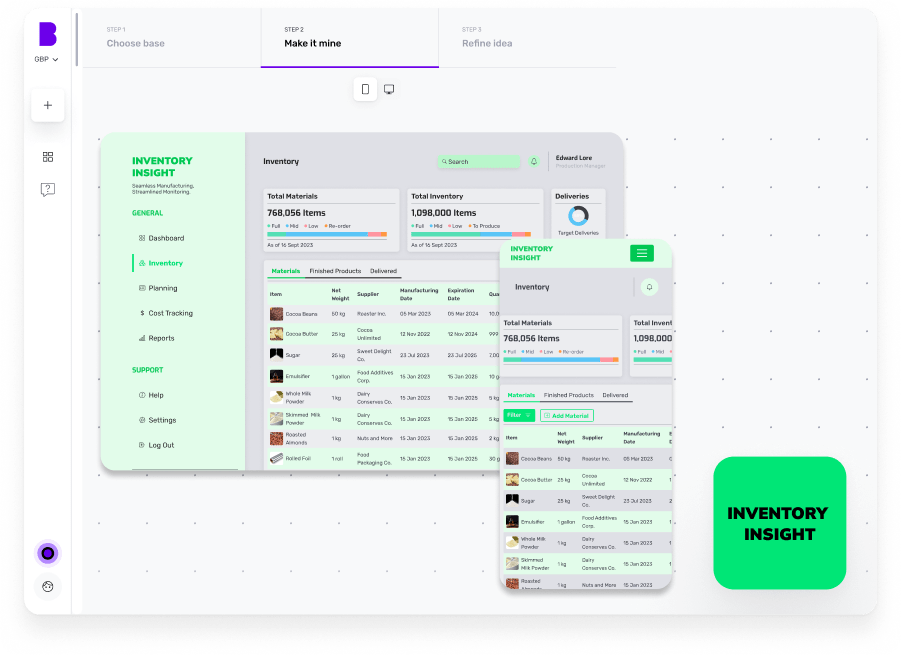
Why Builder.ai is different?
Builder.ai gives you the best of all worlds by offering the flexibility of custom software development without the need to overextend your internal team or navigate the unpredictability of external agencies. With us, you can build educational software that's tailored specifically to the unique needs of your institution.
Around 80% of all software is made up of around 650+ features. We package each basic feature as a reusable Lego-like block. Explain your idea to our AI companion, Natasha, and she uses these blocks to rapidly create an outline of your software.
The work is completed faster and cheaper because Natasha handles all the repetitive coding. Then it’s off to our software design team and software developers. They personalise it and create any bespoke elements you need.
To build your educational software, simply head over to Builder Studio. The Builder Studio platform has been built with user convenience in mind and intuitively guides you through the software creation process.
Let’s dive in to the step-by-step process 👇
1 - Discuss your ideas with Natasha
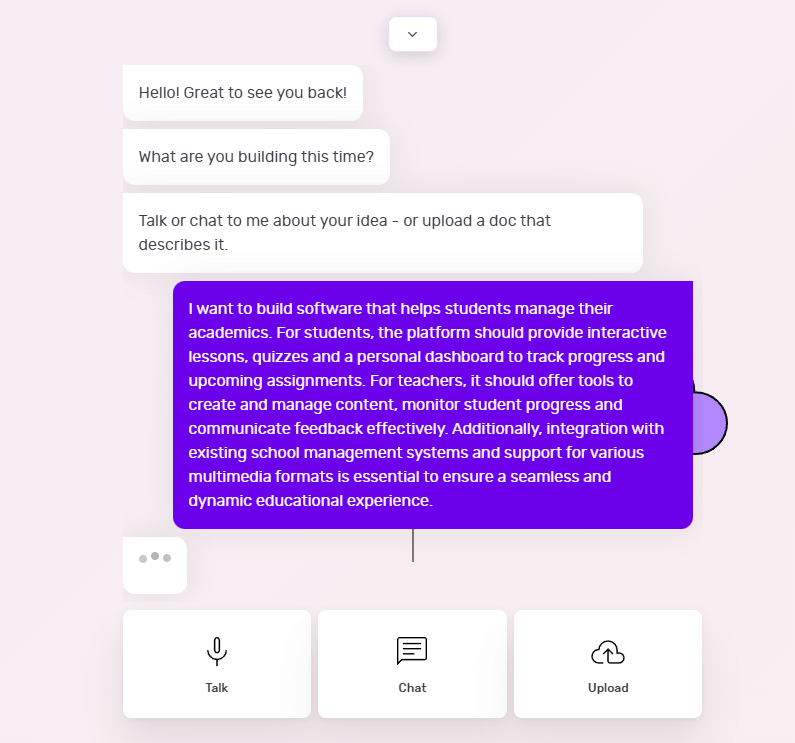
On Builder Studio, you’re welcomed by Natasha. You can express your educational software ideas to Natasha via voice, text or uploading a PDF or doc file.
Before you chat with her, have a checklist of software features and be as descriptive as possible about your software idea. The more detailed information you give to Natasha, the better her suggestions will be.
For instance, a prompt could look like this:
“I want to build software that helps students manage their academics. For students, the platform should provide interactive lessons, quizzes and a personal dashboard to track progress and upcoming assignments.
“For teachers, it should offer tools to create and manage content, monitor student progress and communicate feedback effectively.
“Additionally, integration with existing school management systems and support for various multimedia formats is essential to ensure a seamless and dynamic educational experience.”
Based on your prompt, Natasha will ask you some supporting questions and you simply need to answer them based on your requirements.
2 - Choose a base
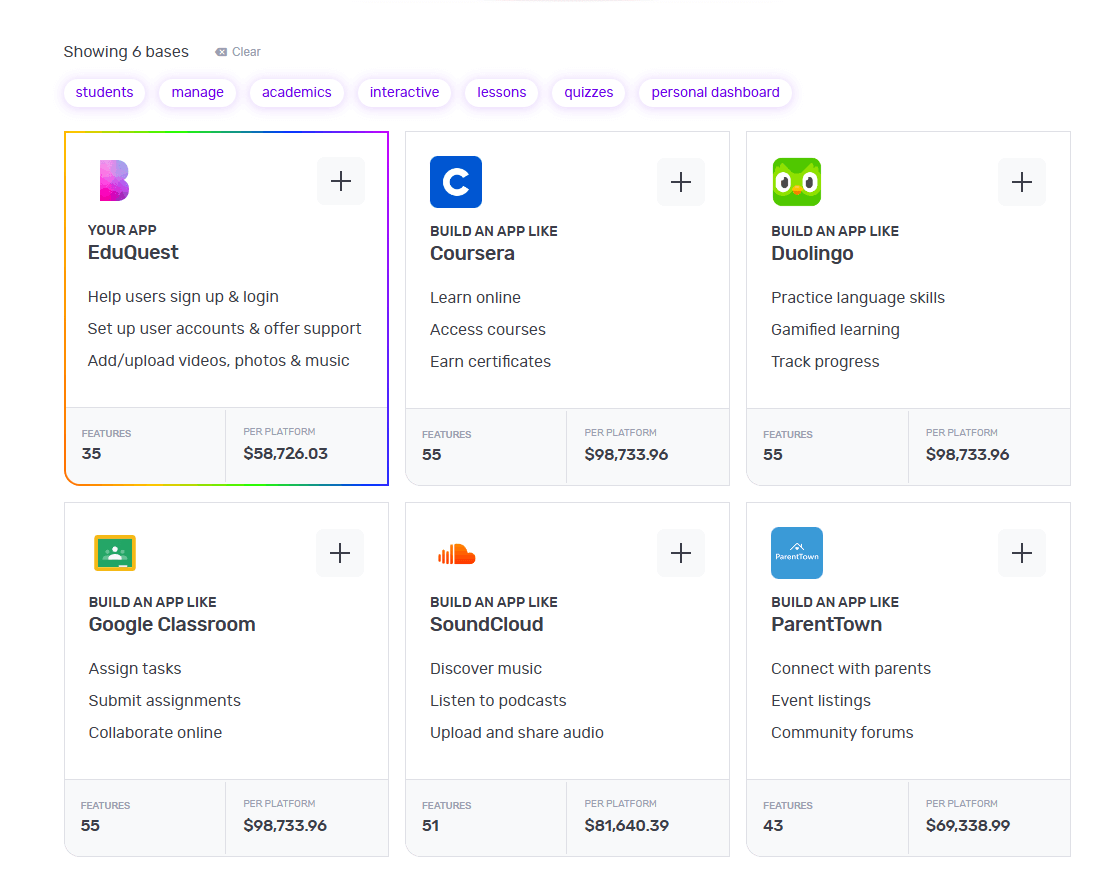
Once Natasha has your requirements, she’ll create a custom framework for your software based on everything you tell her. She'll also suggest some pre-built bases she thinks are best suited for your software.
For instance, once you tell her to build educational software, she’ll suggest a custom base similar to Coursera and share any matching core bases as well.
You can choose up to 3 you feel are related to your big idea by simply clicking the ‘+’ icon. These selections make it easier for us to understand the features your software needs. When you’re ready, click 'Next'.
3 - Make it mine
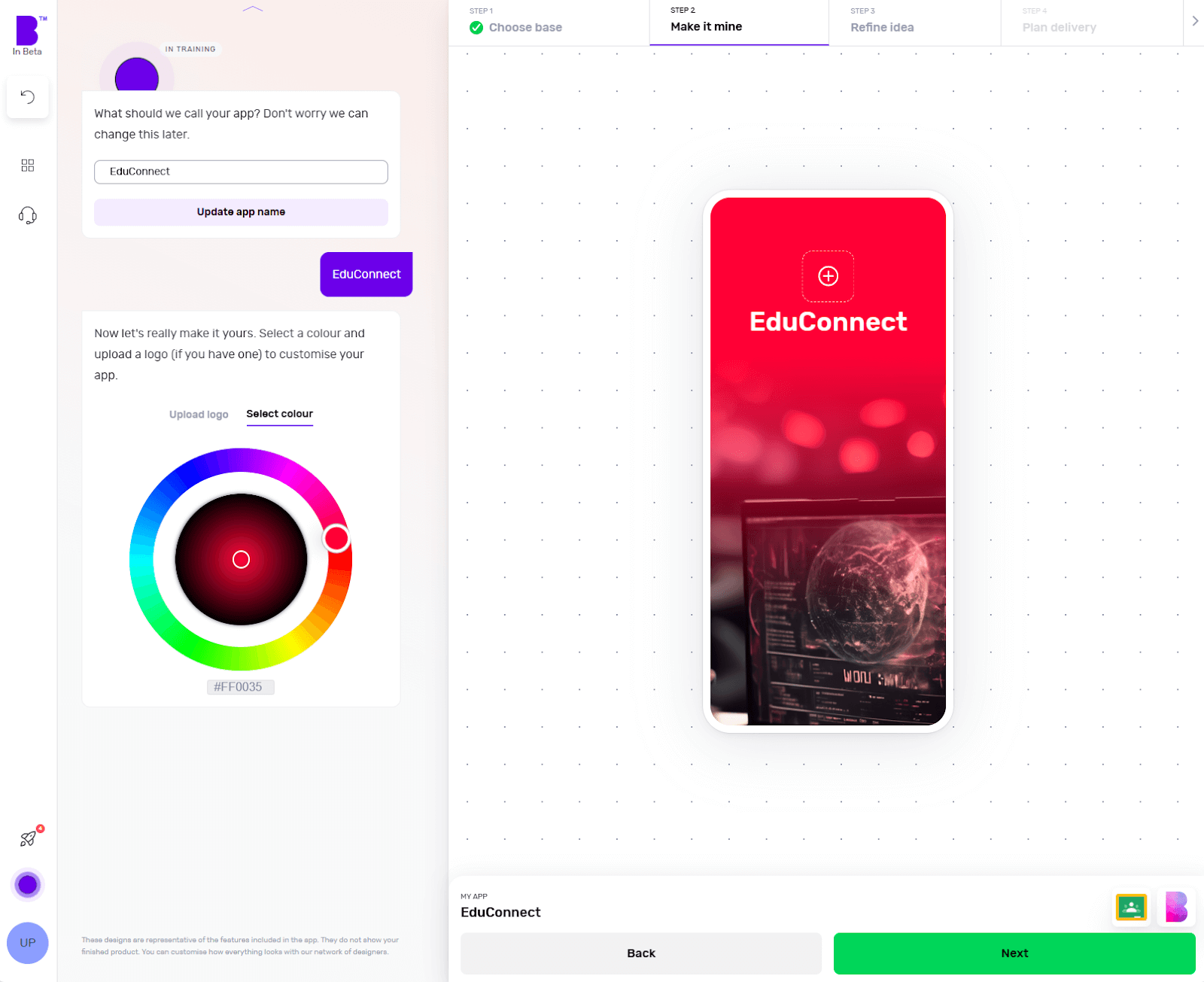
The 'Make it mine' step aligns your software with the identity of your brand. In this step, you provide your software’s name, choose the colour scheme using the colour wheel and upload the logo of your brand.
Once you’ve personalised your software’s name, colour and logo, you can click ‘Next’.
4 - Refine your software idea
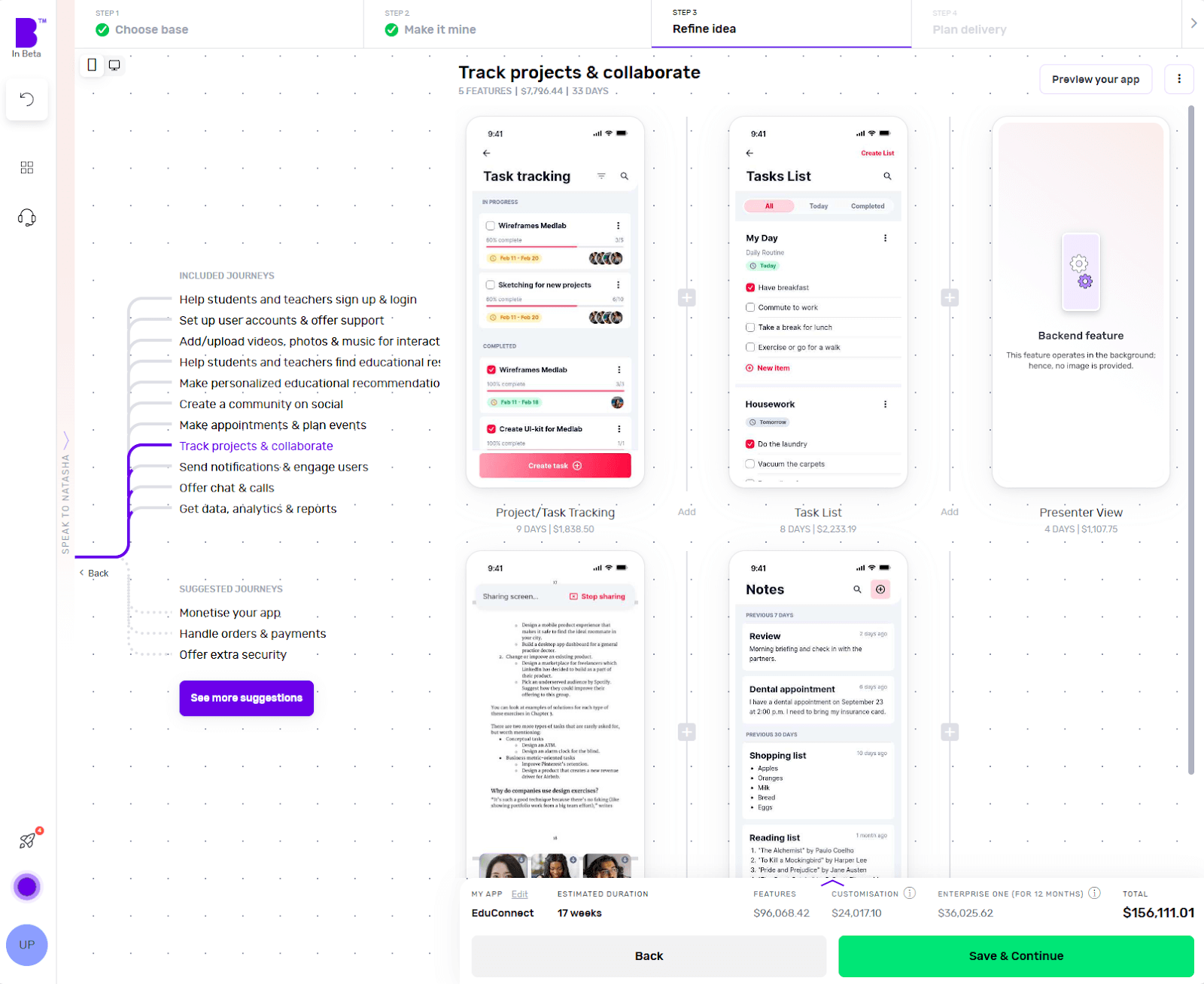
Now comes the fun bit.
In the 'Refine idea' stage, you can review and customise your software journeys and features and also create an instant prototype of your software.
Journeys
In only a matter of seconds, Natasha createssoftware user journeys with corresponding features.
Go through these journeys carefully and see if your software needs additional journeys. For instance, check if you want to add journeys for tracking logistics, customised order status or any other relevant journey.
To add journeys, click on 'See more suggestions'. Doing so will open the list of pre-built journeys. You can browse the list and select the journeys you’re missing. You can also add custom journeys by clicking on 'Add custom journey'.
Features
By clicking on individual journeys, you can see the feature list each journey contains. Doing so will open the features list each journey contains. You can scroll through the features list and check if a journey contains non-essential features or if you want to add extra features.
To remove a non-essential feature, you can hover over the feature and click ‘Remove’. This way you can manage project costs. If you’re not sure what features to remove, you can click on an individual feature and check the label at the top. We highly recommend keeping the ‘Essential Features’.
In case you want to add more features, you can simply click the ‘+’ button. Here you can go through different categories or use the search bar to look for missing functionality. In case you don’t find the feature you’re looking for, you can also add a custom feature by clicking on 'Add custom feature'.
Instant prototype and user flow
Once you’re happy with the journeys and features of your software, you can create a prototype by clicking on 'Preview your app' in the top-right corner.
Sign up and Natasha will create a working prototype of your software. You can click on the screen at different areas to progress through the journey.
You can also see theuser flow by clicking on the 'Flow mode' at the top of the screen to see how users will interact and navigate within your software.
If you need extra help, Natasha is on hand to help and you can interact with her at any time by clicking on 'Speak to Natasha'.
She’ll provide you suggestions and help you find features or journeys from the library. Or you can click on 'Book a demo' to talk to our product managers who’ll guide you through your software development journey.
Click on 'Save & Continue' to go to the next step and also to save your progress or it might get lost.
5 - Plan delivery
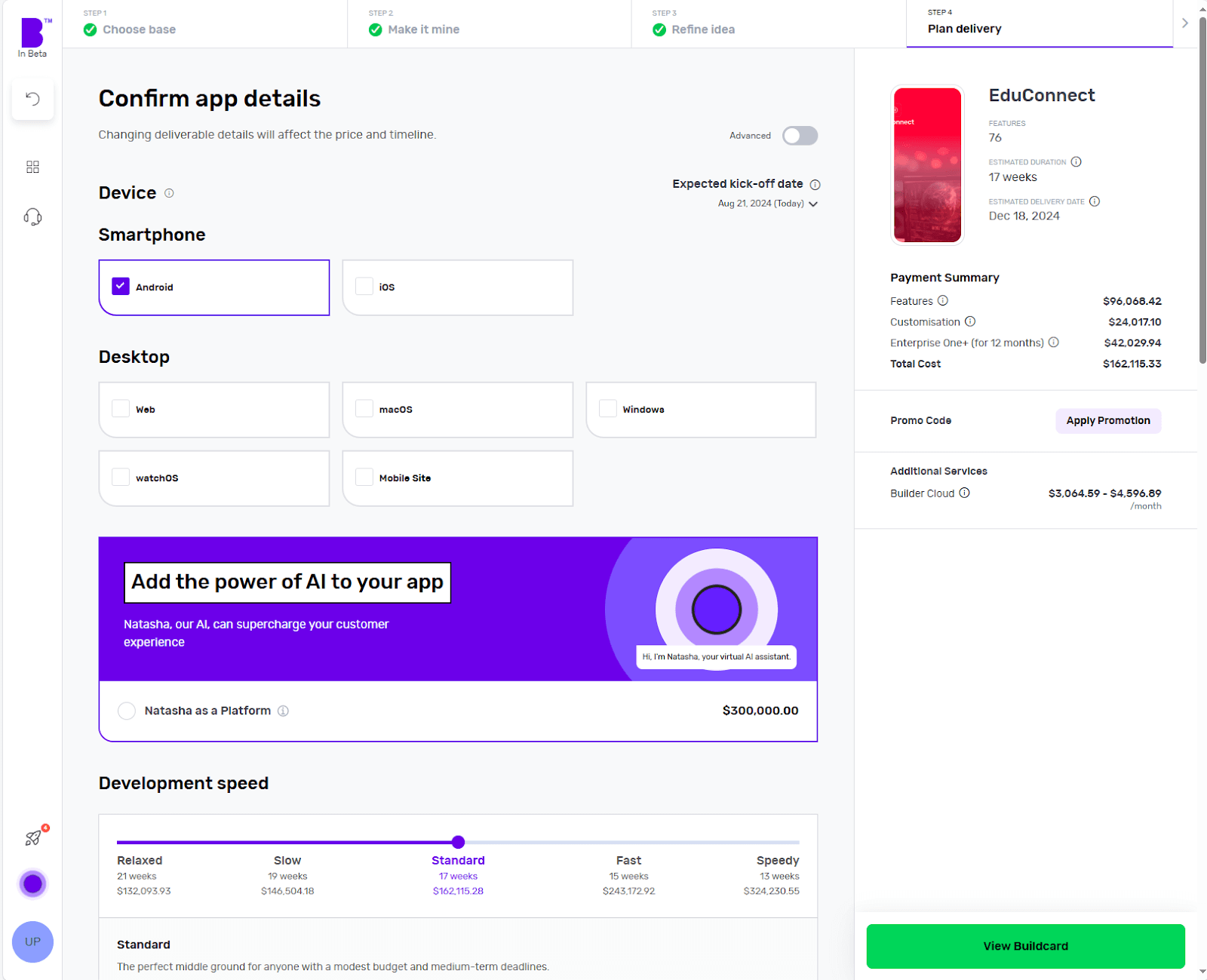
It’s time to choose the platforms you want your educational software to be available on. Want a desktop app? Click Windows or macOS. Fancy a mobile app? Hit Android or iOS. Not sure about the platform? Choose multiple platforms and see how it changes the price and timelines.
Next, you can choose to add Natasha to your platform to supercharge the customer experience of your educational software. Natasha uses Large Language Models (LLMs) to engage your customers in fluid, human-like conversations.
In the development speed section, can change the speed of each phase according to your needs. The faster the development speed, the higher the costs and vice versa.
Next up is Design. If you have your software designs ready, you can save on your costs by clicking 'You have design' and we’ll reduce your costs accordingly. You can share your design files (preferably in Figma) and our designers will upload them, so you can kick off straight away.
If not, you can choose the 'We do your designs' option. Here, you simply need to add your brand assets and we'll do everything from storyboarding to fully designed screens.
Now it’s time to plan the phases of your project. Here you get 3 options:
- Clickable prototype: you’ll get a visual representation of your software to test with users
- Basic build: you’ll get an MVP (Minimum viable product) – a hard-coded but simplified version of your idea; this allows you to collect feedback and iterate before you do a full build
- Full Build: you’ll get market-ready software, including a kick-off with our product team and review sessions
After that, you need to select your support plans. With 'Full Build' you get one year of Studio One support included free of charge.
Once you’ve planned your delivery, click on 'View Buildcard'.
6 - Review Buildcard
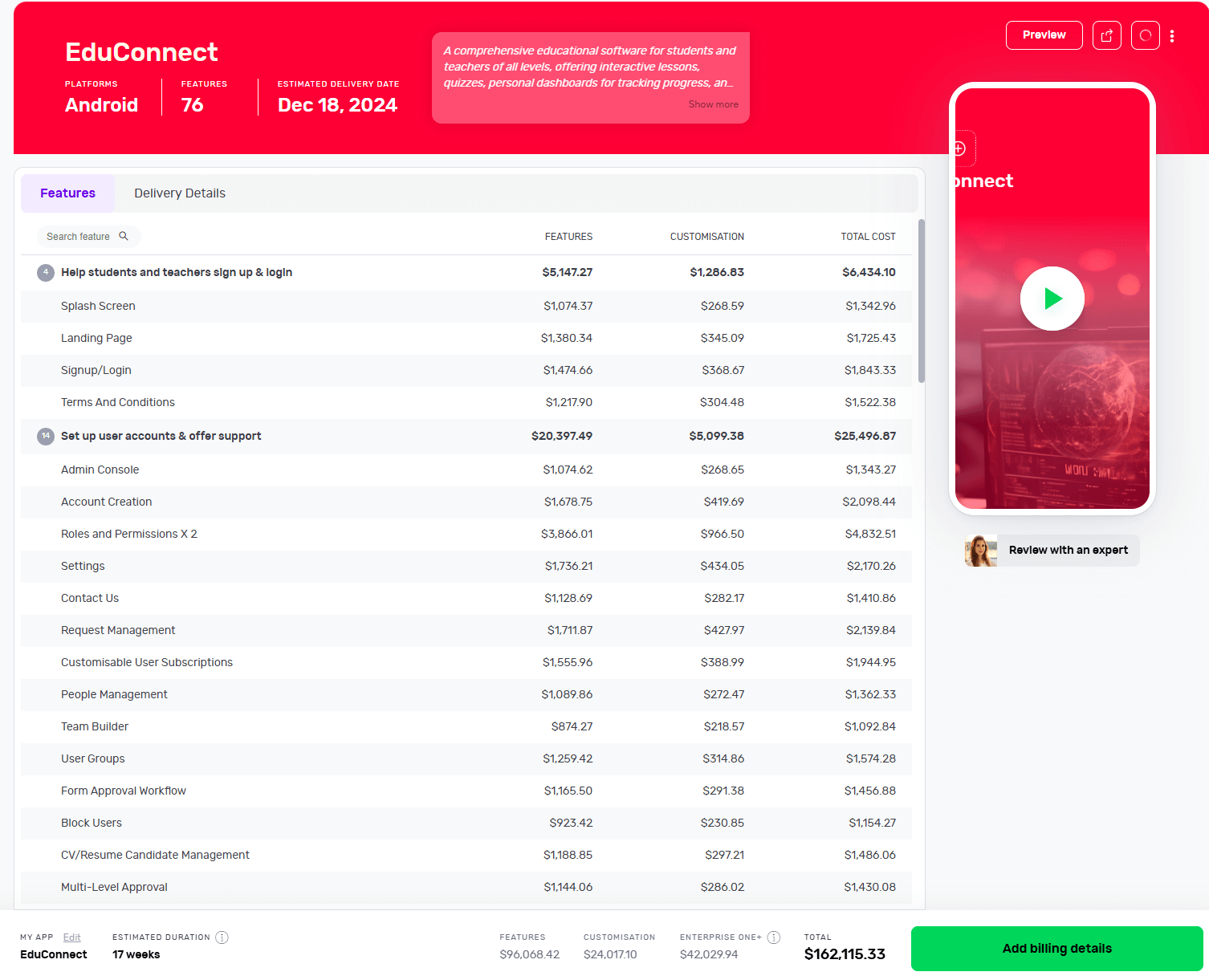
Buildcard provides you with a bird's eye view of all the selections you made in the previous steps. Here, you can review all the features, cost per feature and delivery details.
You can also download the PDF of Buildcard or invite others to show your team members what you’re building.
If you want to make any changes, simply click on 'Edit Buildcard' under the 3 dots in the top-right corner.
If you’re happy with everything, click on 'Add billing details' to go to the next section. Alternatively, if you want to review it with experts, click on 'Review with an expert'.
7 - Select your payment plan
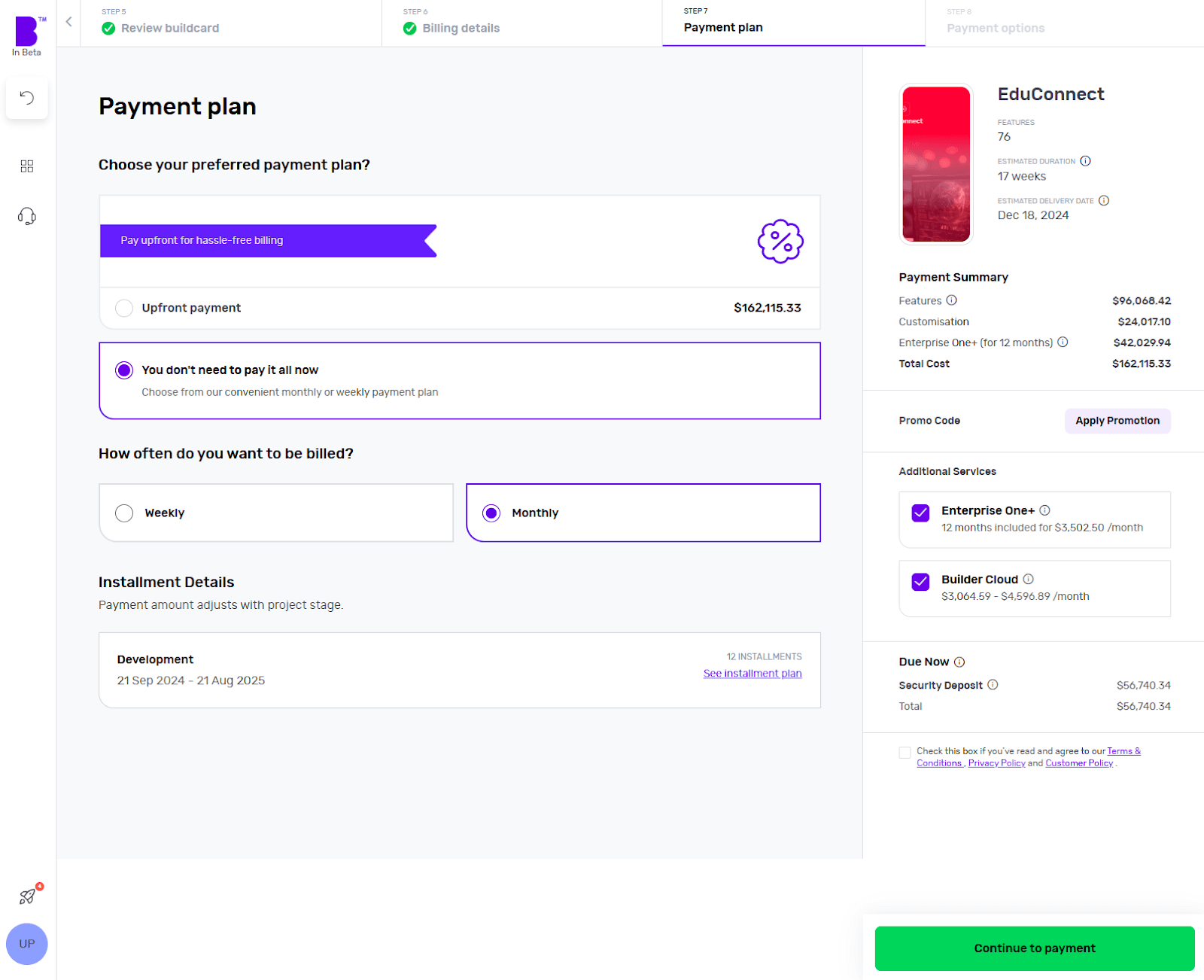
We offer weekly or monthly payment instalments, with visible payment dates and amounts for each option. You can also choose to pay upfront to reduce the cost of your build.
Simply select your preferred billing cycle, then click 'Continue' to proceed.
You’ll be asked to input your payment details and agree to the terms and conditions. Once that’s done, click 'Continue to Payment'.
Once your payment is done, you can set up a meeting with our product managers to begin your software development.
8 - Monitor your software build in real-time
With Builder Home, your real-time project dashboard, you can monitor development progress and make sure your software is exactly the way you want it.
This includes access to a suite of collaboration tools to help improve your software design. You can chat with your team of experts in Builder Meet, brainstorm in Builder Whiteboard and visualise your ideas with free Tailor-made prototypes from Builder Now.
How Builder.ai ensures success for educational organisations
At Builder.ai, we have expertise in assisting educational enterprises increase their profits and scale their operations. 👇
Frankfinn
Frankfinn, the world’s number 1 cabin crew training institute, was looking to scale its training programmes to support exponential business growth objectives.
Frankfinn worked with Builder.ai to migrate and set up their infrastructure on AWS Cloud in accordance with AWS best practices.
Frankfinn benefited from the economies of scale and efficiencies provided by AWS but paid only for the compute, storage and other resources as per use.
Learners India
Learners India helps teachers monitor students during online learning. They can also quickly change lessons to meet children's needs.
They had limited manual monitoring systems that prevented them from proactively addressing and troubleshooting issues.
Builder.ai helped them restructure their existing infrastructure on AWS with the best practices like High Availability and IaaC.
How Builder.ai keeps your software secure
Builder.ai has a robust, cloud-based security infrastructure. This is divided between Microsoft Azure and AWS (Amazon Web Services), ensuring high availability, scalability and reliability for our services.
Who has access?
Safeguarding our systems and those of our customers and partners is paramount. We operate on a Zero Trust Model, meaning we grant access only when necessary and on a need-to-know basis.
Here's how we manage access:
- Strict controls – we tightly regulate access to all internal services and products
- Least-privilege basis – we follow the principle of least privilege, granting access only to the services required
- Identity access management (IAM) – we use IAM to control access to the cloud providers we use; this ensures that only authorised individuals and systems can interact with the essential services they need
Where do we store data?
Customer data is securely stored in data centres operated by our cloud service providers. These data centres adhere to strict security standards and compliance certifications such as SOC 2, ISO 27001 and GDPR.
What do we do to keep data secure?
Builder.ai is committed to protecting the privacy of customer data and adheres to relevant data protection regulations such as GDPR and CCPA (where applicable). We have comprehensive privacy policies in place.
We subscribe to the AWS and Azure Well-Architected frameworks.
These include:
- Least privilege – we ensure that users have only the necessary access to perform their tasks, enhancing security
- Real-time monitoring – we monitor activities constantly and receive alerts immediately to detect and respond to any suspicious behaviour
- Layered security – we implement security measures at every level to provide comprehensive protection against threats
- Automated best practices – we automate security protocols by embedding them into our code, ensuring consistency and efficiency
- Data protection – we secure data both in transit and at rest to prevent unauthorised access or breaches
- Minimised data access – we limit direct access to data, reducing the risk of exposure to unauthorised individuals
- Incident preparedness – we have a robust incident management process in place to effectively handle security incidents when they occur
You can find out more about our security policy here 👈
Conclusion
Educational institutions face the challenge of digitalising while also improving learners' experiences.
The solution? Software.
With your own custom software, you can make learning more interactive, efficient and personalised to each student. With the right features and a user-centric approach, educational software can boost your teaching and help your students learn effectively.
Hit the banner below and kick off your educational software project with us today 👇
Create robust custom software today
100s of businesses trust us to help them scale.
Book a demoBy proceeding you agree to Builder.ai’s privacy policy
and terms and conditions

Gaurav is the SEO Content Writer at Builder.ai. Being an Engineer and Marketing MBA, he has a knack for converting technical jargon into marketing content. He has 8+ years of experience creating content and designing marketing campaigns that drive organic growth for B2B companies and tech startups.

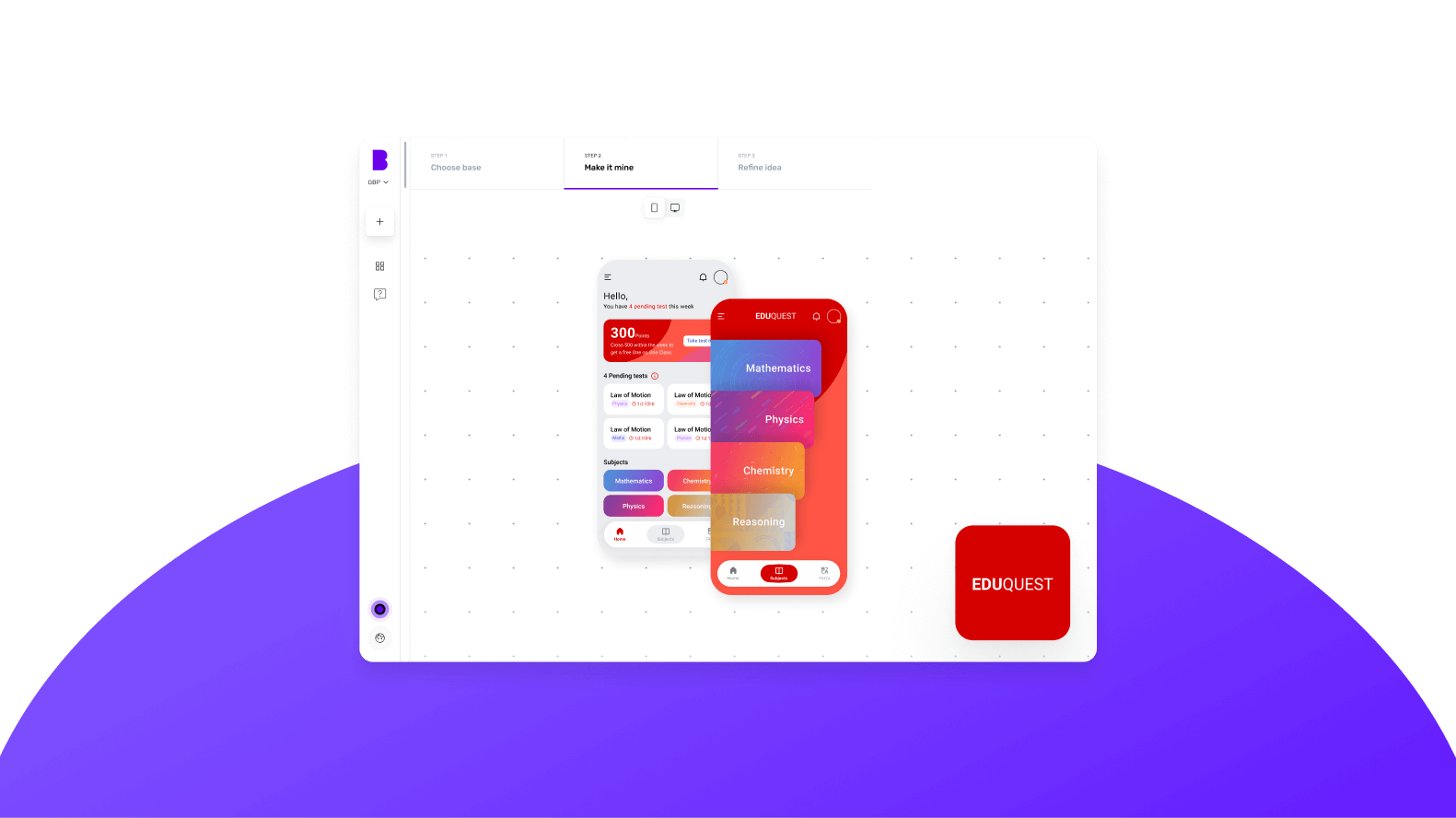








 Facebook
Facebook X
X LinkedIn
LinkedIn YouTube
YouTube Instagram
Instagram RSS
RSS


